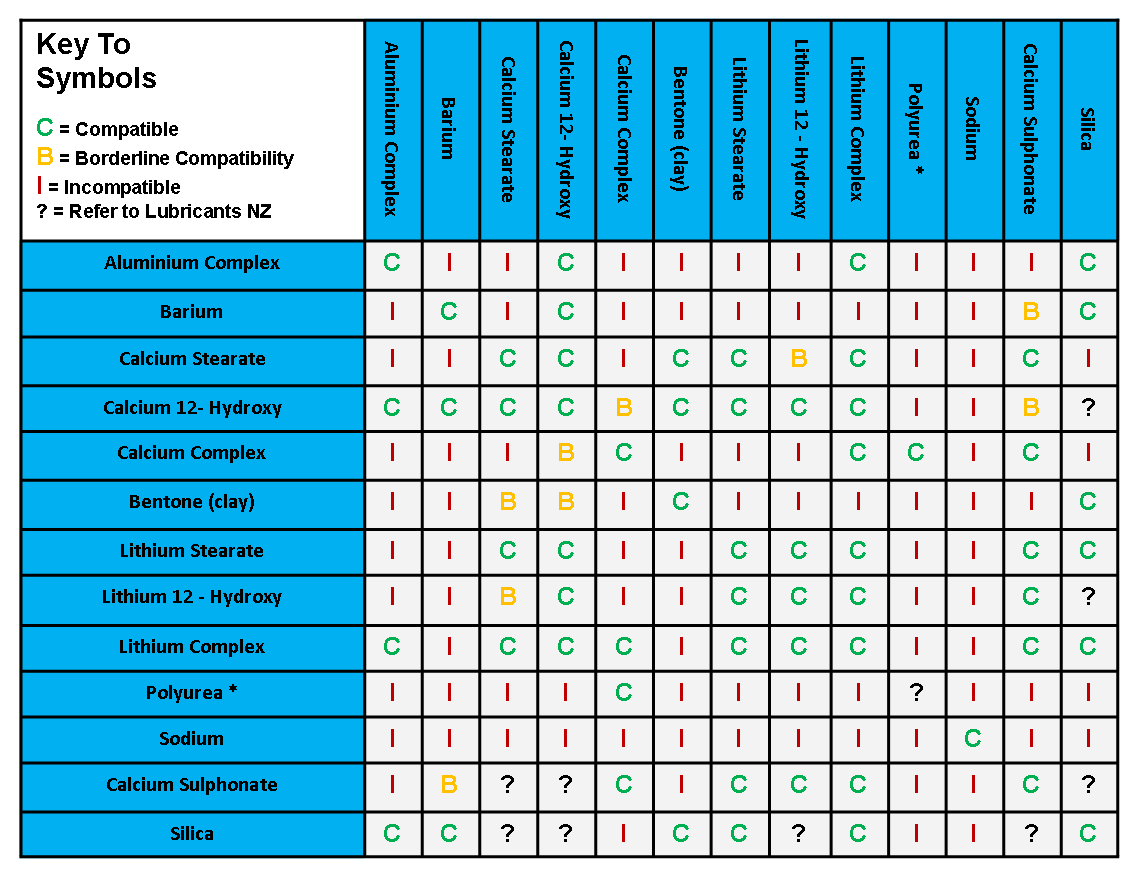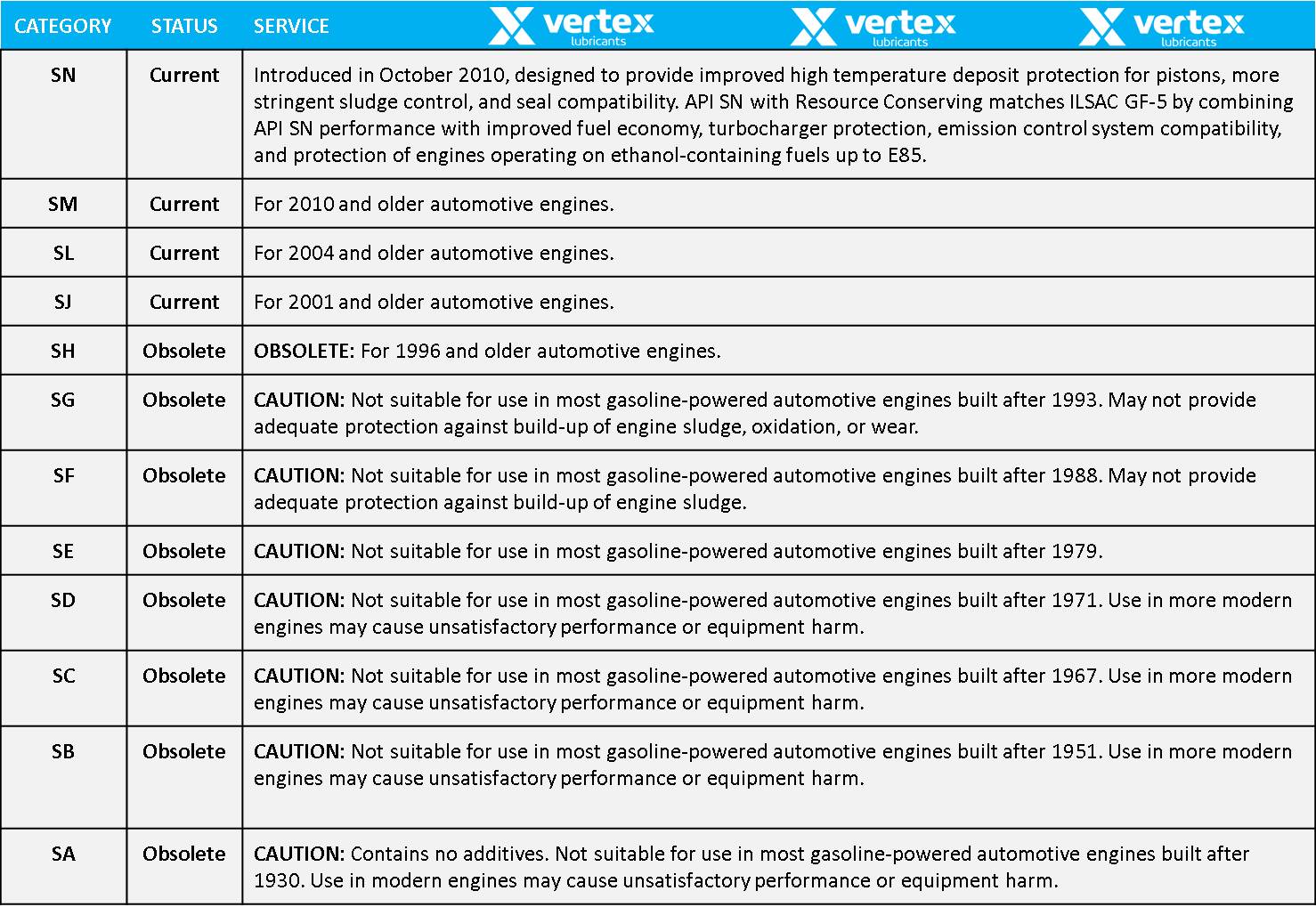Updated API Licenses for Vertex
The Vertex brand is now officially API licensed for it’s petrol and diesel range of oils.

Role of Lubricants
There are 6 Basic Functions of a Lubricant/Oil.
- Lubrication – Provide a film between moving parts.
- Cooling – Heat transfer media.
- Sealing – Filling in uneven surfaces
- Cleaning – Holding contaminants in suspension.
- Dampening & Cushioning – Of components under high stress.
- Protection – From oxidation & corrosion.
The key defining properties of a lubricant/oil are:
- Viscosity – Viscosity, by definition, is an oil’s resistance to flow and shear. The most common unit of measure for viscosity is the Kinematic viscosity and this is usually quoted in data sheets at 40°C and 100°C. The commonly used unit of measure is centistokes but the correct SI unit of measure is mm2/s.
- Viscosity Index – Viscosity index (VI) is an arbitrary measure for the change of viscosity with variations in temperature. The lower the VI, the greater the change of viscosity of the oil with temperature and vice versa. It is used to characterise viscosity changes with relation to temperature in lubricating oil.
- Pour Point – The pour point of an oil is the lowest temperature at which it will pour when cooled under defined conditions.
- Demulsibility – Demulsibility is the ability of a lubricant to release water and readily separate when mixed. Because oil is hygroscopic, meaning that it absorbs water, this is a very important property of lubricating oils.
- Oxidation Resistance – The ability of a lubricant to withstand the presence of oxygen. The rate of oxidation is accelerated by high temperatures, water, acids and catalysts such as copper. Oxidation will lead to an increase in the oil’s viscosity and deposits of varnish and sludge. The rate of oxidation doubles with every 10º C rise in temperature.
- Thermal Stability – Thermal stability is defined as the ability of a fluid to resist breaking down under heat stress. As such, the maximum use temperature is the suggested maximum temperature to which the fluid can be heated before the fluid begins to break down or degrade at an appreciable rate. A fluid with high thermal stability will degrade less than a fluid with low thermal stability and will deliver a longer fluid life than a less stable fluid.
There are a myriad of others, that if it is of interest to you, please sign up to our newsletter for more regular and detailed information. Or alternatively contact our technical team about scheduling a tailored training session for you and your team.
The key additives of a lubricant/oil are:
Surface Protectants
- Detergents – Designed to keep surfaces free of deposits.
- Dispersants – One end of these additives are soluble in oil and the other attracts dirt, sludge & other contaminants & holds them in suspension in the oil.
- Rust & Corrosion Inhibitors – Designed to prevent corrosion & rusting of metal parts in contact with the lubricant.
- Anti Wear & EP Agents – Designed to reduce friction & wear and prevent scoring & wear. Chemical reaction with metal surface forms a film with lower shear strength than the metal. Thereby preventing metal to metal contact.
- Friction Modifiers – Minimises light surface contacts (sliding & rolling) that may occur in a given machine design. These are also called boundary lubrication additives.
Performance Agents
- Seal Swell Agents – Their express purpose is to swell elastomeric seals. This is caused by a chemical reaction with elastomer to cause slight seal swell as specified by the manufacturer (OEM).
- Viscosity Improvers – VI improvers (also known as viscosity modifiers) are additives that increase the viscosity of the fluid throughout its useful temperature range. Viscosity improvers are polymeric molecules that are sensitive to temperature. At low temperatures, the molecule chain contracts and does not impact the fluid viscosity. At high temperatures, the chain relaxes and an increase in viscosity occurs.cosity modifiers are polymeric molecules that are sensitive to temperature.
- Pour Point Depressants – Designed to enable lubricants to flow at lower than normal temperatures (compared to the base oil in its natural state). In general, the pour point is indicative of the amount of wax in an oil. At low temperatures, the wax tends to separate, trapping a substantial amount of oil, inhibiting oil flow and hindering lubrication.
Lubricant Protectants
- Antifoam Agents – Prevents lubricants from forming a persistent foam. Reduces the surface tension of the fluid to speed the collapse of foam. Often composed of silicone polymers or organic copolymers.
- Antioxidants – Compounds designed to retard oxidative decomposition. Oxidation will lead to an increase in the oil’s viscosity and deposits of varnish and sludge. The rate of oxidation doubles with every 10º C rise in temperature. This vicious cycle leads to an increase in rust and corrosion, resulting in metal damage from oxygen and acid attack. Water and polar impurities increase the speed of attack.
- Emulsifying & Demulsifying Agents – A chemical process whereby hydrophillic surfactants chelate (trap) water droplets in the oil. This promotes the formation of a stable mixture of oil & water. This assists in coalescing water droplets to increase the ability of water and oil to separate.
- Metal Deactivators – Reduces the catalytic effect of metals on oxidation rates. This assists by forming an inactive film on metal surfaces by complexing with metallic ions.
Base oil groups
Mineral oil is a term used to encompass lubricating base oil derived from crude oil. The American Petroleum Institute (API) designates several types of lubricant base oil:
- Group I – Saturates <90% and/or sulfur >0.03%, and Society of Automotive Engineers (SAE) viscosity index (VI) of 80 to 120
Manufactured by solvent extraction, solvent or catalytic dewaxing, and hydro-finishing processes. Common Group I base oil are 150SN (solvent neutral), 500SN, and 150BS (brightstock) - Group II – Saturates over 90% and sulfur under 0.03%, and SAE viscosity index of 80 to 120
Manufactured by hydrocracking and solvent or catalytic dewaxing processes. Group II base oil has superior anti-oxidation properties since virtually all hydrocarbon molecules are saturated. It has water-white color. - Group III – Saturates > 90%, sulfur <0.03%, and SAE viscosity index over 120
Manufactured by special processes such as isohydromerization. Can be manufactured from base oil or slax wax from dewaxing process. - Group IV – Polyalphaolefins (PAO)
- Group V – All others not included above such as naphthenics, PAG, esters.
In North America, Groups III, IV and V are now described as synthetic lubricants, with group III frequently described as synthesised hydrocarbons, or SHCs. In Europe, only Groups IV and V may be classed as synthetics.
What Does Viscosity Mean
Viscosity is another type of bulk property defined as a liquid’s resistance to flow. Simply put, viscosity is an oil’s speed of flow as measured through a device known as a viscometer. The thicker (higher viscosity) of an oil, the slower it will flow. You will see oil viscosity measurement in technical data sheets stated in kinematic (kv) and absolute (cSt) terms. These are translated into the easier to understand SAE and ISO viscosity numbers you see on oil bottles and product names. Viscosity describes the internal friction of a moving fluid. A fluidwith high viscosity resists motion because its molecular makeup gives it a lot of internal friction. A fluid with low viscosity flows easily because its molecular makeup results in very little friction when it is in motion.
Viscosity Classifications

Engine Oil Specifications – ILSAC
ILSAC Standard For Passenger Car Engine Oils
Petrol Engine Oil Specifications – API
API Standard For Petrol Engine Oils
Petrol Engine Oil Specifications – API
API Standard For Diesel Engine Oils
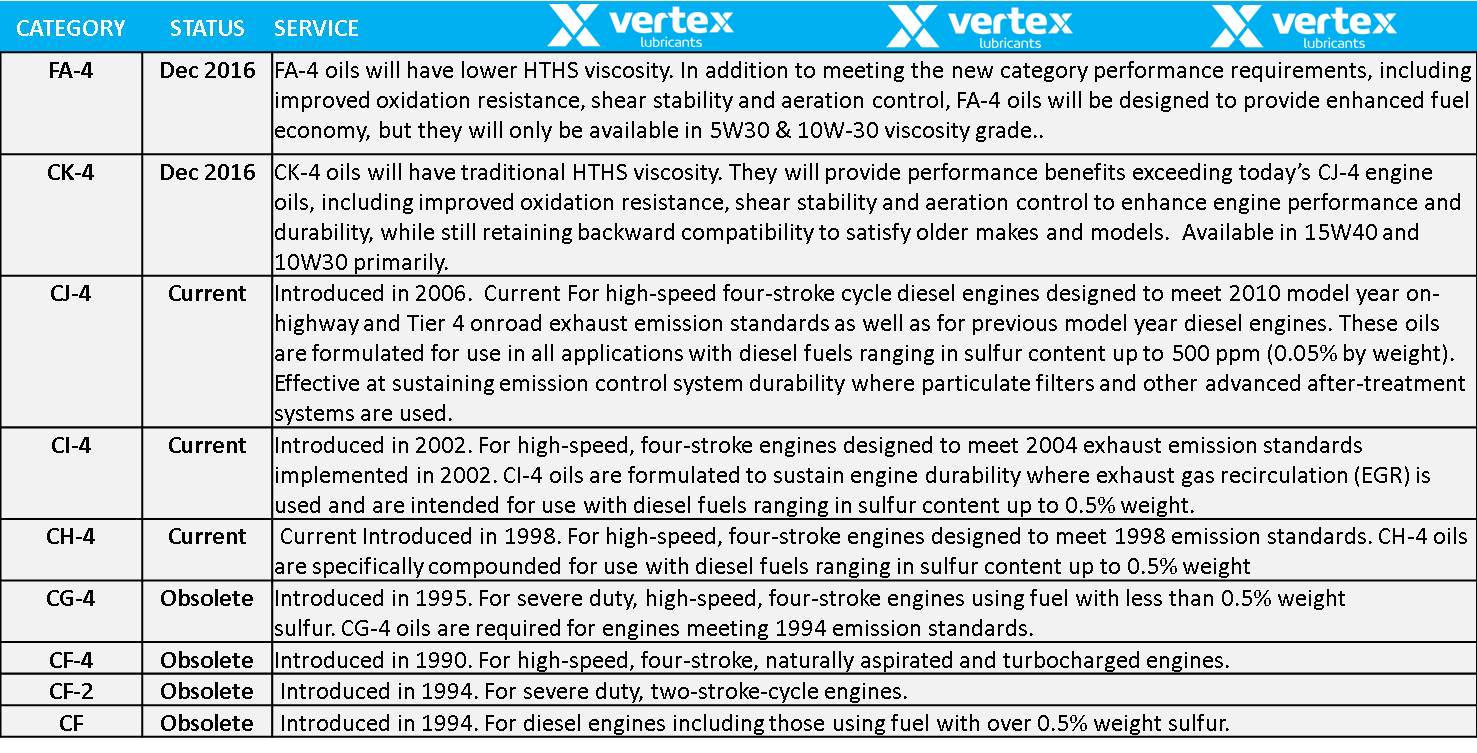
Please note that API engine oil specifications ARE backwards compatible.
Engine Oil Specifications – ACEA
A/B: gasoline and diesel engine oils
- ACEA A1/B1 Stable, stay-in-grade oil intended for use at extended drain intervals in gasoline engines and car & light van diesel engines specifically designed to be capable of using low friction low viscosity oils with a high temperature / high shear rate viscosity of 2.6 mPa*s for xW/20 and 2.9 to 3.5 mPa.s for all other viscosity grades.
- ACEA A3/B3 Stable, stay-in-grade oil intended for use in high performance gasoline engines and car & light van diesel engines and/or for extended drain intervals where specified by the engine manufacturer, and/or for year-round use of low viscosity oils, and/or for severe operating conditions as defined by the engine manufacturer.
- ACEA A3/B4 Stable, stay-in-grade oil intended for use in high performance gasoline and direct injection diesel engines, but also suitable for applications described under A3/B3.
- ACEA A5/B5 Stable, stay-in-grade oil intended for use at extended drain intervals in high performance gasoline engines and car & light van diesel engines designed to be capable of using low friction low viscosity oils with a High temperature / High shear rate (HTHS) viscosity of 2.9 to 3.5 mPa.s.
C: Catalyst compatibility oils
- ACEA C1 Stable, stay-in-grade oil intended for use as catalyst compatible oil in vehicles with DPF and TWC in high performance car and light van diesel and gasoline engines requiring low friction, low viscosity, low SAPS oils with a minimum HTHS viscosity of 2.9 mPa.s. These oils will increase the DPF and TWC life and maintain the vehicles fuel economy. Warning: these oils have the lowest SAPS limits and are unsuitable for use in some engines.
- ACEA C2 Stable, stay-in-grade oil intended for use as catalyst compatible oil in vehicles with DPF and TWC in high performance car and light van diesel and gasoline engines designed to be capable of using low friction, low viscosity oils with a minimum HTHS viscosity of 2.9mPa.s. These oils will increase the DPF and TWC life and maintain the vehicles fuel economy. Warning: these oils are unsuitable for use in some engines. Consult owner manual or handbook if in doubt.
- ACEA C3 Stable, stay-in-grade oil intended for use as catalyst compatible oil in vehicles with DPF and TWC in high performance car and light van diesel and gasoline engines, with a minimum HTHS viscosity of 3.5mPa.s. These oils will increase the DPF and TWC life. Warning: these oils are unsuitable for use in some engines. Consult owner manual or handbook if in doubt.
- ACEA C4 Stable, stay-in-grade oil intended for use as catalyst compatible oil in vehicles with DPF and TWC in high performance car and light van diesel and gasoline engines requiring low SAPS oil with a minimum HTHS viscosity of 3.5mPa.s. These oils will increase the DPF and TWC life. Warning: these oils are unsuitable for use in some engines. Consult owner manual or handbook if in doubt.
E: Heavy Duty Diesel engine oils
- ACEA E4 Stable, stay-in-grade oil providing excellent control of piston cleanliness, wear, soot handling and lubricant stability. It is recommended for highly rated diesel engines meeting Euro I, Euro II, Euro III, Euro IV and Euro V emission requirements and running under very severe conditions, e.g. significantly extended oil drain intervals according to the manufacturer’s recommendations. It is suitable for engines without particulate filters, and for some EGR engines and some engines fitted with SCR NOx reduction systems. However, recommendations may differ between engine manufacturers so Driver Manuals and/or Dealers shall be consulted if in doubt.
- ACEA E6 Stable, stay-in-grade oil providing excellent control of piston cleanliness, wear, soot handling and lubricant stability. It is recommended for highly rated diesel engines meeting Euro I, Euro II, Euro III, Euro IV, Euro V and Euro VI emission requirements and running under very severe conditions, e.g. significantly extended oil drain intervals according to the manufacturer’s recommendations. It is suitable for EGR engines, with or without particulate filters, and for engines fitted with SCR NOx reduction systems. E6 quality is strongly recommended for engines fitted with particulate filters and is designed for use in combination with low sulphur diesel fuel. However, recommendations may differ between engine manufacturers so Driver Manuals and/or Dealers shall be consulted if in doubt.
- ACEA E7 Stable, stay-in-grade oil providing effective control with respect to piston cleanliness and bore polishing. It further provides excellent wear control, soot handling and lubricant stability. It is recommended for highly rated diesel engines meeting Euro I, Euro II, Euro III, Euro IV and Euro V emission requirements and running under severe conditions, e.g. extended oil drain intervals according to the manufacturer’s recommendations. It is suitable for engines without particulate filters, and for most EGR engines and most engines fitted with SCR NOx reduction systems. However, recommendations may differ between engine manufacturers so Driver Manuals and/or Dealers shall be consulted if in doubt.
- ACEA E9 Stable, stay-in-grade oil providing effective control with respect to piston cleanliness and bore polishing. It further provides excellent wear control, soot handling and lubricant stability. It is recommended for highly rated diesel engines meeting Euro I, Euro II, Euro III, Euro IV, Euro V and Euro VI emission requirements and running under severe conditions, e.g. extended oil drain intervals according to the manufacturer’s recommendations. It is suitable for engines with or without particulate filters, and for most EGR engines and for most engines fitted with SCR NOx reduction systems. E9 is strongly recommended for engines fitted with particulate filters and is designed for use in combination with low sulphur diesel fuel. However, recommendations may differ between engine manufacturers so Drivers Manuals and/or Dealers should be consulted if in doubt.
Please note that ACEA engine oil specifications ARE NOT backwards compatible.
Gear Oil Specifications – API
Please note that API gear oil specifications ARE NOT backwards compatible.
Composition of a Grease
By definition grease is a semi-fluid to solid consistency product, obtained by thickening agent dispersion in a liquid lubricant. To give special properties, specific products can also be added. Grease is perhaps one of the more misunderstood products in our industry. People attach a lot of relevance to oil (as they should) but istakenly buy their grease based upon colour preference or price. Ironically more work often goes into making a grease than an oil.
Grease v Oil
Why would you use an grease instead of an oil?
- Greases lubricate bearings simply and cheaply.
- Keeps lubricant in the component to be lubricated.
- Equipment used in stop and go conditions (lubricant film maintained during machine stop) = less wear during machine start.
- Effective bearing sealing from water, dust, contaminants etc…
- Lifetime lubrication.
- Noise & vibration reduction as grease acts like a damper.
- Shock absorbtion grease acts like a suspension.
- Perfect for high load -low speed conditions.
- Low heat evacuation capability.
- No contaminants evacuation can equal higher abrasive wear.
- Low operating speed due to viscous friction.
- Pumpability limits usually at low temperatures and when circuits are long.
Base Soap Qualities
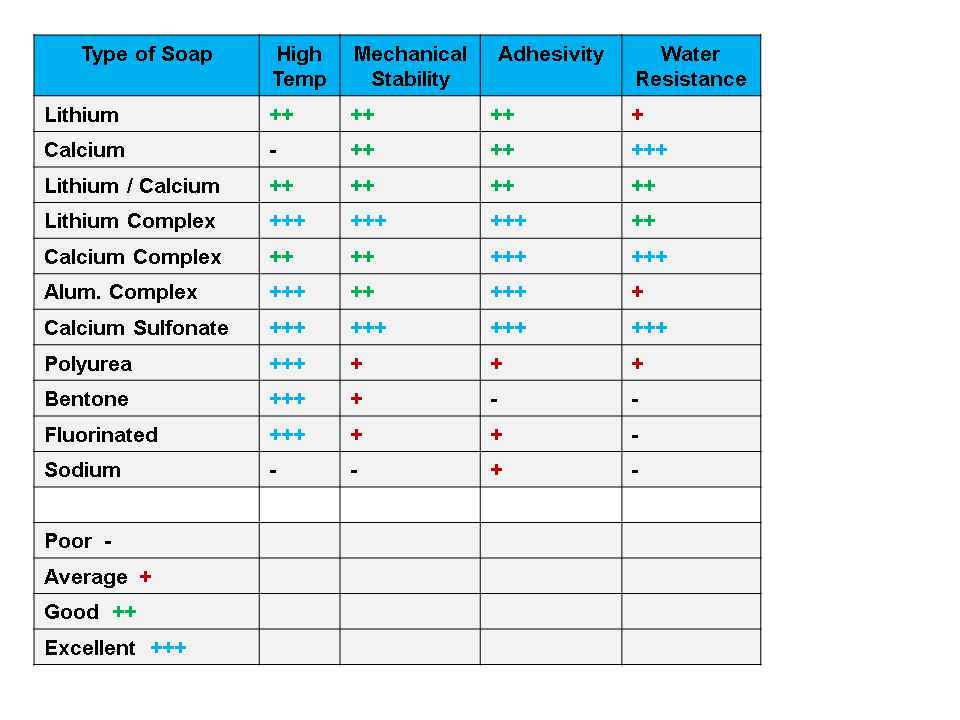
Grease Grades
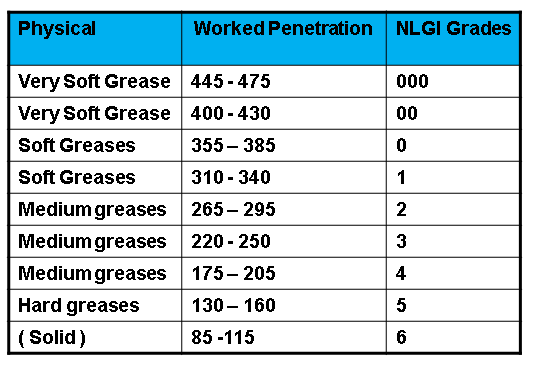
Generic Grease Applications
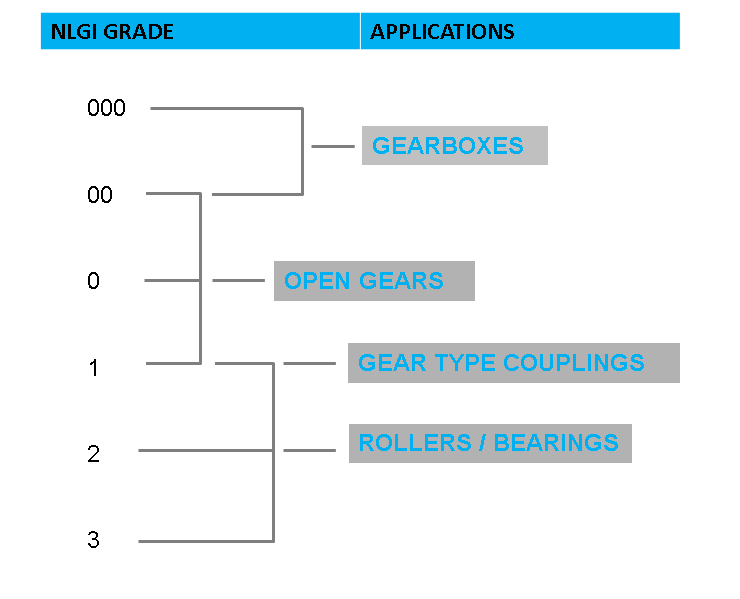
Grease Compatability
